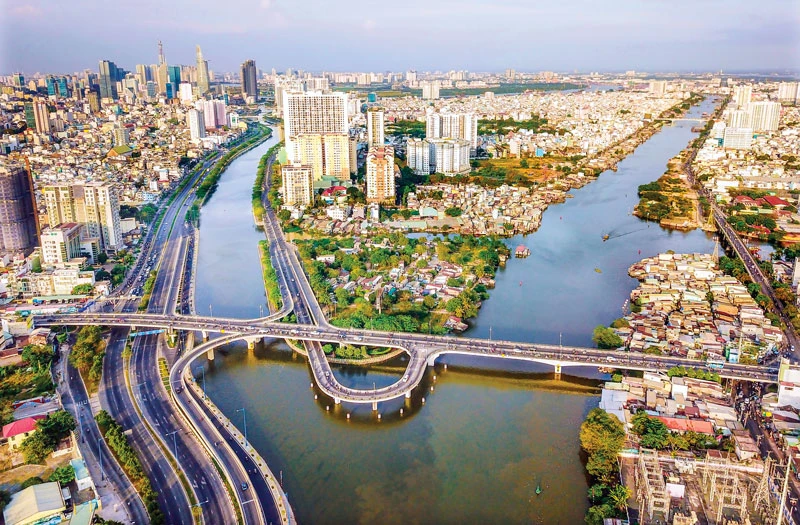
Hence, there is real concern over the fact that Ho Chi Minh City only holds 18 percent of the revenue for its annual upkeep and all ongoing development projects.
Budget distribution
Since Vietnam’s State Budget Law took effect in 2002, the revenue amount for Ho Chi Minh City from the total budget revenue is only 18 percent, while 82 percent is adjusted in the central government budget. On the positive side, regulating this budget implies a re-allocation of income from rich provinces and productive businesses to poorer provinces that face many difficulties. However, this budget distribution also has its downside, such as lack of investment for development projects, while the regulatory budget for other provinces could likely lead to more dependency. On the other hand, several localities sometimes "don't want to be big", or some provinces are not really poor but still want a slice of the central budget. For this reason, data from these provinces is not very credible.
This paradox has been happening for many years. Every province wants to achieve growth in Gross Regional Domestic Product (GRDP), but when people have to create wealth or generate financial resources, they begin to shirk. From this, the question that needs to be carefully studied is the criteria to assess rich and poor status of all provinces. Otherwise, the economically efficient provinces in general and Ho Chi Minh City in particular, which is considered a “cash cow", will lose motivation and growth opportunities from lack of investment funds.
A recent report of the People's Committee of Ho Chi Minh City shows that in 11 months of 2019, the total state budget revenue of the City was around VND 412,474 bn, reaching 103.34% of the estimate and up by 9.01% over the previous year. If domestic revenue alone is considered, it is estimated to achieve 97.85%, an increase of 9.63% compared to the previous year. If excluding revenue from the Ministry of Finance towards the local budget, the estimated domestic revenue reached 91.53%. In particular, for revenue from the economic sector, even Ho Chi Minh City has implemented synchronous solutions from the beginning of the year. These solutions support and develop the economy to nurture and mobilize revenue sources, resulting in an increase of 8.93% over the same period, but still not reaching the assigned estimate of just over 90%.
The reason is that the Central Government assigns the revenue from the economic sector to increase far too high an amount compared to the implementation in 2018 (up 20.97%), exceeding the ability to mobilize revenue in the area. Regarding budget expenditure of the City in 2019, it is estimated to implement VND 77,718 bn which includes expense of income payment increase by VND 7,244 bn, of which regular expenditure is at VND 47,027 bn, and expenditure for development investment is at VND 22,611 bn.
Domino effect
Theoretically, a country always has some industries that are relatively more important than other sectors in the economy, through diffusion index and sensitivity. Similarly, a region or province has particular importance and may have more important diffusion in the national economy than other regions or provinces. Research of inter-regional models in Vietnam show that the demand for GRDP in Ho Chi Minh City has spread to other regions very strongly.
Specifically, the diffusion index of Ho Chi Minh City is 1.5 times higher than in the northern provinces, 1.7 times higher than in the central provinces, and 1.9 times more than in the remaining provinces in the south. More specifically, HCMC household consumption has spread to other regions, 1.6 times higher than in the northern provinces, 1.72 times higher than in the central provinces and the rest of the southern regions. Besides, investment has also spread strongly to regions, especially in the field of exports.
Currently, manufacturing of export products in Ho Chi Minh City has spread to other regions twice more than other regions exports to HCMC. Interestingly, in all eight economic regions, Ho Chi Minh City is the only region with so many economic sectors and the largest diffusion index. This shows that Ho Chi Minh City has many industries that can spearhead growth and spread to inner cities as well as other economic regions.
Notably, the spread of investment that is a fixed asset from the state capital of Ho Chi Minh Province, is impressive and higher than other regions. For example, the diffusion index of HCMC is 1.51, while Hanoi is the second highest with 1.304. The diffusion index of the private sector in terms of investment in fixed assets in Ho Chi Minh City is also the highest among eight regions, at 1.25. As for investment in movable assets in all seven regions, the diffusion is less than 1, while HCMC is much higher than 1. In addition, when the intrinsic demand of Ho Chi Minh City increases, including consumption, investment and exports, it is estimated that the spread to the inner city will reach around 85% and spread to other regions will be 15%.
Thus, from an economic perspective, it can be considered that Ho Chi Minh City is a particularly important region that plays a leading role in the entire economy of the country. Therefore, if the economy of Ho Chi Minh City slows down, it will not only have a direct negative impact on the nation as a whole, but will also have a domino effect on other regions as well, in subsequent phases.




















